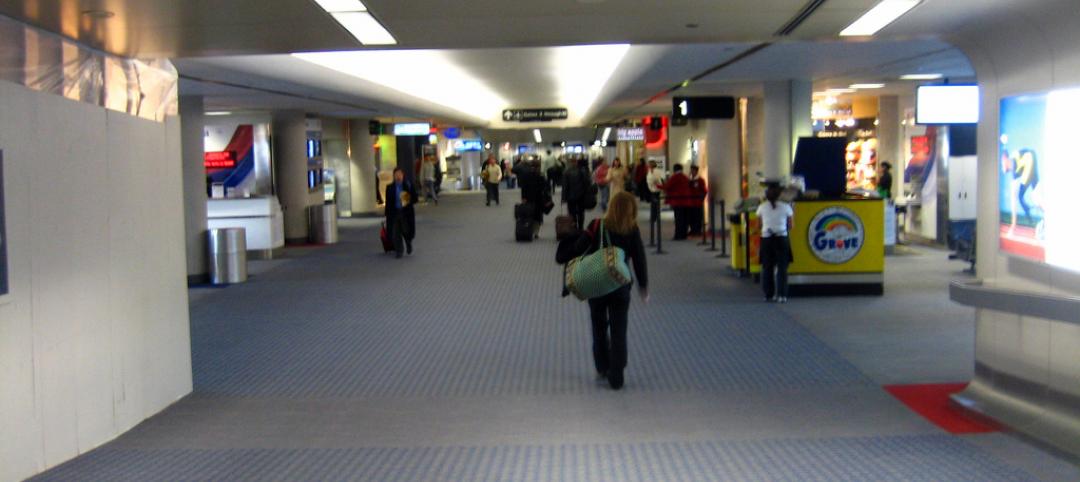Kansas City International Airport’s new 1 million-sf terminal has broken ground. The project, which is designed by SOM, will set a new standard for inclusivity and accessibility.
The 39-gate terminal will have the flexibility to expand to 50 gates in the future. At the entrance, a large overhang, supported by structurally expressed Y columns, and a glass facade will create a grand and transparent space while retail spaces and two concourses will step down toward a human scale. The rhythmic expressed steel structural system is balanced by a natural wood inlay to provide inviting spaces for passengers. Outdoor waiting areas will leverage the site’s surrounding natural landscape to provide a calming space.

The design forgoes creating a sprawling terminal and instead focuses on quick and seamless transitioning with a compact layout: walking distances are kept to a minimum, check-in and security are consolidated into one space, and a dual-level roadway will separate the vehicular traffic between arrivals and departures, with the terminal’s entrance and passenger-parking facilities located on either side to make the entire airport walkable.
The terminal will feature a variety of spaces with the goal of increasing inclusivity and accessibility. A multi-sensory room will provide a quiet and secure place for people with autism, dementia, or sensory processing disorders. An airplane simulation room will help people with anxiety or other conditions that create a fear of flying. This room allows people in experience and fear about air travel through true-to-life objects like a ticketing kiosk, gate door, passenger boarding bridge, and simulated aircraft cabin.

Other inclusivity and accessibility features include a meditation room, a family play zone, all gender restrooms, family restrooms, infant nursing rooms, service animal relief areas, and adult-assist changing rooms.
In addition to SOM, the build team also includes Edgemoor Infrastructure & Real Estate (developer), and Clark | Weitz | Clarkson (design-builder).
The new terminal is targeting LEED Gold certification. The project is slated for completion in 2023.


Related Stories
| Dec 8, 2014
Moshe Safdie wants to reinvent airports with Jewel Changi Airport addition
A new addition to Singapore's Changi Airport, designed by Moshe Safdie, will feature a waterfall and extensive indoor gardens.
| Nov 19, 2014
The evolution of airport design and construction [infographic]
Safety, consumer demand, and the new economics of flight are three of the major factors shaping how airlines and airport officials are approaching the need for upgrades and renovations, writes Skanska USA's MacAdam Glinn.
| Nov 18, 2014
Grimshaw releases newest designs for world’s largest airport
The airport is expected to serve 90 million passengers a year on the opening of the first phase, and more than 150 million annually after project completion in 2018.
| Nov 14, 2014
JetBlue opens Gensler-designed International Concourse at JFK
The 175,000-sf extension includes the conversion of three existing gates to international swing gates, and the addition of three new international swing gates.
Sponsored | | Nov 12, 2014
Eye-popping façade highlights renovation, addition at Chaffin Junior High School
The new distinctive main entrance accentuates the public face of the school with an aluminum tube “baguette” system.
| Oct 26, 2014
New York initiates design competition for upgrading LaGuardia, Kennedy airports
New York Gov. Andrew Cuomo said that the state would open design competitions to fix and upgrade New York City’s aging airports. But financing construction is still unsettled.
| Oct 16, 2014
Perkins+Will white paper examines alternatives to flame retardant building materials
The white paper includes a list of 193 flame retardants, including 29 discovered in building and household products, 50 found in the indoor environment, and 33 in human blood, milk, and tissues.
| Oct 12, 2014
AIA 2030 commitment: Five years on, are we any closer to net-zero?
This year marks the fifth anniversary of the American Institute of Architects’ effort to have architecture firms voluntarily pledge net-zero energy design for all their buildings by 2030.
| Sep 24, 2014
Architecture billings see continued strength, led by institutional sector
On the heels of recording its strongest pace of growth since 2007, there continues to be an increasing level of demand for design services signaled in the latest Architecture Billings Index.
| Sep 22, 2014
4 keys to effective post-occupancy evaluations
Perkins+Will's Janice Barnes covers the four steps that designers should take to create POEs that provide design direction and measure design effectiveness.
















